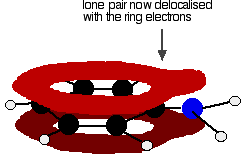|
THE REACTION BETWEEN PHENYLAMINE (ANILINE) AND BROMINE WATER This page looks at the reaction of the benzene ring in phenylamine (aniline) with bromine water. It explains why the amino group activates the ring. Activation of the ring The -NH2 group attached to the benzene ring in phenylamine has the effect of making the ring much more reactive than it would otherwise be. This is exactly the same as the effect of the -OH group in phenol if you have already come across that. For example, phenylamine will react with an aqueous solution of bromine (bromine water) in the cold and in the absence of any catalyst. Unactivated rings will only react with bromine in the presence of a catalyst. The lone pair on the nitrogen touches the delocalised ring electrons . . .
. . . and becomes delocalised with them:
| ||
|
Note: If you don't understand these diagrams, you will need to read about bonding in benzene in order to make sense of them. If you follow this link, you may have to explore several other pages before you are ready to come back here again. Use the BACK button (or HISTORY file or GO menu) on your browser to return to this page. | ||
|
A benzene ring undergoes substitution reactions in which the ring electrons are attacked by positive ions or the slightly positive parts of molecules. In other words, it undergoes electrophilic substitution. If you increase the electron density around the ring by involving extra electrons from the -NH2 group, it becomes even more attractive to incoming electrophiles. That's what happens in phenylamine. | ||
|
Note: If you aren't sure what any of these terms mean, you could find out by following this link to a page introducing electrophilic substitution. If you choose to follow this link, use the BACK button (or the HISTORY file or GO menu) on your browser to return to this page later. | ||
|
The directing effect of the -NH2 group The -NH2 group has more activating effect on some positions around the ring than others (for reasons which go beyond UK A level). That means that incoming groups will go into some positions much faster than they will into others. The net effect of this is that the -NH2 group has a 2,4-directing effect. That means that incoming groups will tend to go into the 2- position (next door to the -NH2 group) or the 4- position (opposite the -NH2 group). You will get hardly any of the 3- isomer formed - it is produced too slowly. The reaction with bromine water If bromine water is added to phenylamine, the bromine water is decolourised and a white precipitate is formed. This is exactly like the reaction which happens with phenol. The precipitate is 2,4,6-tribromophenylamine.
Notice the multiple substitution around the ring - into all the activated positions. (The 6- position is, of course, just the same as the 2- position. Both are next door to the -NH2 group.) | ||
|
Note: Bromine water is normally used as a test for a C=C double bond. The important difference with phenylamine (and phenol) is the formation of a white precipitate as well as the bromine water being decolourised. Since both phenol and phenylamine decolourise bromine water and give a white precipitate, how can you distinguish between them? First, of course, they look entirely different. Phenylamine is usually a brownish oil, whereas phenol has white crystals smelling of disinfectant. If you want a simple chemical test, test their solubilities in sodium hydroxide solution and in dilute hydrochloric acid. Phenol is slightly acidic and so reacts with sodium hydroxide solution to give a colourless solution. Phenylamine is slightly basic and so reacts with dilute hydrochloric acid to give a colourless (or pale brown) solution. Phenol would be no more soluble in dilute hydrochloric acid than it is in water. Similarly, phenylamine would be no more soluble in sodium hydroxide solution than it is in water. | ||
© Jim Clark 2011 (modified April 2016) |
||


